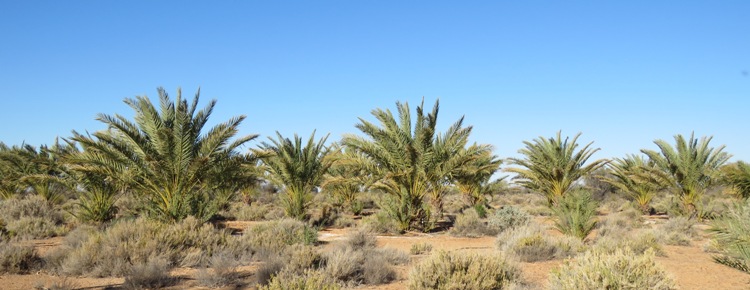Australia So Much to See
The Oodnadatta Track - String of Springs
Although the present day date palms at Coward Springs reputedly were planted by pioneering "Afghan" cameleers, they are in fact remnants
of two acres of date palms planted there in 1898 as part of a South Australian government experimental plantation. A few surviving
date palms from this plantation (near the bore/'spa' and in the camping area) still produce fruit. Ref: Wikipedia.
A grove of date palms for future production were planted by the current owners of Coward Springs (above), with the first 25 palms being planted in 2004. In 2013 suckers were removed and planted. The ultimate ambition would be to have 500 fruit producing date palms.

Coward Springs Campground was once a station on the old Ghan railway line. The site was constructed in 1888 and abandoned before the line was closed in 1980. It was named in 1858 by Peter Egerton-Warburton, the South Australian Commissioner of Police, after Corporal Thomas Coward.
The campground incorporates where the Hotel once stood, with the Hotel having been demolished in 1965
after having operated from 1887 to 1953.
In 1887 a bore was sunk here in preparation for the coming railway. By the 1920's millions of gallons of water flowed without control
over the dry gibber plains. The salty water from the Great Artesian Basin had quickly corroded the bore head and the bore casing to
create an evolving wetland. A large pool also formed where water bubbled from the corroded bore and this became a popular bathing
place for locals, railway crew and travellers.
The bore was rehabilitated in 1993 by the Department of Mines and Energy. It was
redrilled and relined and the flow rate controlled and reduced. The wetlands remain as a bird haven.
The year Lake Eyre filled up - from information boards in the Engine Driver's Cabin museum
.. you might go six or seven days and not see anyone - but weekends there were usually some - and you'd have the Stuart Creel people
used to come over and for quite a few months of the year they'd be busy loading cattle. They used to drove them down and of
course there was water, they could have their last water before they got on the train. So there was a lot of activity then.
...
we got stuck there when the Ghan couldn't get through. And of course road traffic couldn't get through. And there was
just my son and me - for three months - couldn't get through from anywhere, so we lived on rabbits and pigeon, you know those crested
pigeons . . . that's what we used to eat after we ran out of any sort of food ... the year Lake Eyre filled up ... but we had so many
tourists there coming up to see Lake Eyre fill ... I did a lot of trade during that time.
Camping at Coward Springs
Judy Mannix ran a store in the Station Master's House between 1974 and 1979.
A short walk one way to the toilet block with two large cubicles on which Prue has adorned the floor with delightful paintings of
birds and reptiles, and a painting of wetlands birds on the wall. These are pit toilets, kept very clean and plenty of toilet
rolls provided. There are troughs with a tap and handwash outside. The toilet block is also open to days visitors. Closer to our site were the camper's showers, where water is brought to warm by a donkey, wood provided. Two showers are built
in a rustic style, with telegraph insulators used as hooks. Floor mat provided. A trough outside the showers can be used as
a camper's sink. Cold water only. Water is bore water. Tanks at the toilet block provide potable water for camper's
drinking water, but may be unavailable seasonally.
Fees $15 per person per night, with a $2 payable by day visitors, both payable
by cash only.
For booking and updates see Coward Springs
The two roomed cabin has a kitchen/dining area (above left), and another room which I expect was the sleeping quarters. The latter
now houses display and books. Above right is a camel saddle frame.
Following signs to find a suitable camping area for our long rig, we were greeted by Greg, who led us to a very roomy drive-through
site, screened by native vegetation with a number of wildflowers blooming. A friendly and welcoming camp host. Each campsite
has a seat and a fireplace, for which you must bring your own wood. The ground is raked daily around the fireplace and seat.